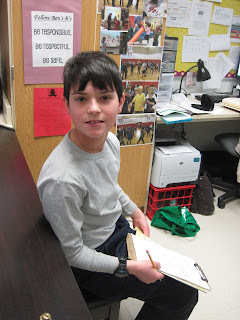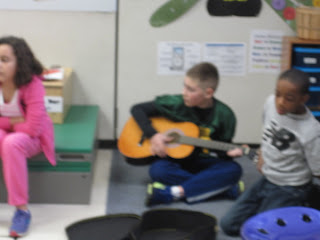2nd grade has been learning about sound in science, and this seemed like a natural place for us to integrate music and science! We have learned all about how sound is created by vibrations, and we wanted to do an experiment to see sound waves at work.
(Check out the hyperlinks below at housingaforest.com for some great pictures and a video of oobleck!)
We made oobleck, which is a substance that isn't quite solid, and isn't quite liquid. We put the oobleck on a cookie sheet on top of a speaker and played some bass tones through the speaker (thanks to Mrs. Bray, who prepped everything for our experiment!) Below are some pictures of the dancing oobleck!
Please come to the music room during open house on Thursday night, 2/28, for an oobleck demonstration and some information about other things we've been learning about in music class!
Wednesday, February 27, 2013
Sunday, February 24, 2013
Kindergarten: One or Two Sounds?
We know a beat is steady, and a rhythm is a combination of long and short sounds. We've been working so hard on keeping a steady beat, and now we're moving onto rhythms! We've been using what we know about syllables, after learning a poem in music class, to determine whether each beat has one sound (or syllable) on a beat, or if it has two.
We learned that when there is one sound on a beat, we call it "ta," and we notate it with one single vertical stick. When there are two sounds on a beat, we call it "ti-ti," and we notate it with two vertical sticks with another stick connecting them across the top. See us notating sounds with popsicle sticks:
The following week, we learned a poem called "Cobbler, Cobbler."
We learned that when there is one sound on a beat, we call it "ta," and we notate it with one single vertical stick. When there are two sounds on a beat, we call it "ti-ti," and we notate it with two vertical sticks with another stick connecting them across the top. See us notating sounds with popsicle sticks:
The following week, we learned a poem called "Cobbler, Cobbler."
Cobbler, cobbler, mend my shoe.
Get it done by half past two.
Half past two is at the door,
Get it done by half past four!
Using our giant beat strips, we used our shoes to notate whether each beat had one or two sounds to it. I cannot even tell you how entertained we all were to take off our shoes in the music room!
 |
| Here's Ms. Falsone, our great student teacher! |
5th Grade is Rockin' and Rollin'!
5th grade said goodbye to our beloved drums at the beginning of February, and since, we have been learning a bit about the history of rock and roll. We've learned about The Beatles, Elvis Presley, and other pioneers of rock and roll.
As we've been learning about some of these rock and roll legends, we've been reviewing how to build chords, how to read chord symbols, and learning how to read guitar chord diagrams in preparation for our guitar unit (which we'll be starting right after spring break).
Here we are doing a little bit of research:
As we've been learning about some of these rock and roll legends, we've been reviewing how to build chords, how to read chord symbols, and learning how to read guitar chord diagrams in preparation for our guitar unit (which we'll be starting right after spring break).
Here we are playing chords for "Hound Dog"on Boomwhackers:
And here we are working in groups to interpret guitar chord diagrams:
1st Grade So-Mi Composition
9/16/15 ***See information on this post on my new website at https://artsintersection.wordpress.com/2015/09/16/floor-staff-strategy-for-teaching-sol-and-mi/
1st grade has been practicing the pitches "so" and "mi" (high and low). We read the book "Brown Bear, Brown Bear, What Do You See?" After some practice composing so-mi pitches for the words of the book as a class and singing them, we split into groups to compose our own animal melodies. We used Zoo Pal plates on 2-line staffs taped to the floor of the music room, and some of us even earned "I Sang By Myself" certificates for singing their compositions for the class! See our work below!
1st grade has been practicing the pitches "so" and "mi" (high and low). We read the book "Brown Bear, Brown Bear, What Do You See?" After some practice composing so-mi pitches for the words of the book as a class and singing them, we split into groups to compose our own animal melodies. We used Zoo Pal plates on 2-line staffs taped to the floor of the music room, and some of us even earned "I Sang By Myself" certificates for singing their compositions for the class! See our work below!
Kindergarten High and Low on Instruments!
"Small is high,
Big is low.
That is science
we should know!"
Kindergartners learned this poem for our first composition activity on the Orff instruments. We learned that small instruments and small bars make high sounds, and big instruments and big bars make low sounds.
We read the book "Brown Bear, Brown Bear, What Do You See?" After reading, we assigned high and low pitches to the words of the book. We sang our composition, and then went to the instruments and spent some time using our knowledge of high/low instrument bars and high/low sounds to figure out how to play our composition.
4th Grade February Recap: Chords and Ballads
4th grade has been quite busy! We've been exploring several different musical topics and they've been intersecting in different ways!
We learned about how to build chords. A chord is a combination of 2 or more notes being played at the same time. We have learned how to build triads (1-3-5) based on chord symbols, and played chords on Boomwhackers and bass bars along with the song "Love Somebody" (which also taught us about the pitch "fa"). Soon, we'll be learning about I-V chord progressions.
We have also been doing some cross-curricular learning about ballads. 4th grade has been learning about ballads with their classroom teachers, so this seemed like a natural point of integration because ballads can be poems or songs! We read The Edmund Fitzgerald: The Song of the Bell. We then listened to Gordon Lightfoot's "The Wreck of the Edmund Fitzgerald," identified chord changes, and then built and played chordal accompaniment along with the song.
That's just a bit of what we've been up to! We've also been continuing our learning about opera, so stay tuned for information about our study of both opera seria and opera buffa!
We learned about how to build chords. A chord is a combination of 2 or more notes being played at the same time. We have learned how to build triads (1-3-5) based on chord symbols, and played chords on Boomwhackers and bass bars along with the song "Love Somebody" (which also taught us about the pitch "fa"). Soon, we'll be learning about I-V chord progressions.
We have also been doing some cross-curricular learning about ballads. 4th grade has been learning about ballads with their classroom teachers, so this seemed like a natural point of integration because ballads can be poems or songs! We read The Edmund Fitzgerald: The Song of the Bell. We then listened to Gordon Lightfoot's "The Wreck of the Edmund Fitzgerald," identified chord changes, and then built and played chordal accompaniment along with the song.
That's just a bit of what we've been up to! We've also been continuing our learning about opera, so stay tuned for information about our study of both opera seria and opera buffa!
Wednesday, February 6, 2013
Instrument Families and "The Young Person's Guide to the Orchestra"
2nd grade has been learning about families of instruments in the orchestra: strings, woodwinds, brass, and percussion. We listened to Benjamin Britten's "Young Person's Guide to the Orchestra," which features each family as well as the orchestra as a whole. First, we listened and followed a listening map. Next, we used our imaginations to come up with pictures, images, words, moods, etc. that each family reminded us of, and we put those images on paper. This reinforced the "voice" of each family so that we could more readily recall what each family sounded like in our next activity.
We assigned colors to each family of the orchestra (green, red, yellow, and blue), and each student was assigned a flashlight that shines one of those colors. We then listened to our piece of music and created a light show by recognizing each family's sound and shining our flashlights on the ceiling when we heard our "color."
We assigned colors to each family of the orchestra (green, red, yellow, and blue), and each student was assigned a flashlight that shines one of those colors. We then listened to our piece of music and created a light show by recognizing each family's sound and shining our flashlights on the ceiling when we heard our "color."
Subscribe to:
Comments (Atom)




















































